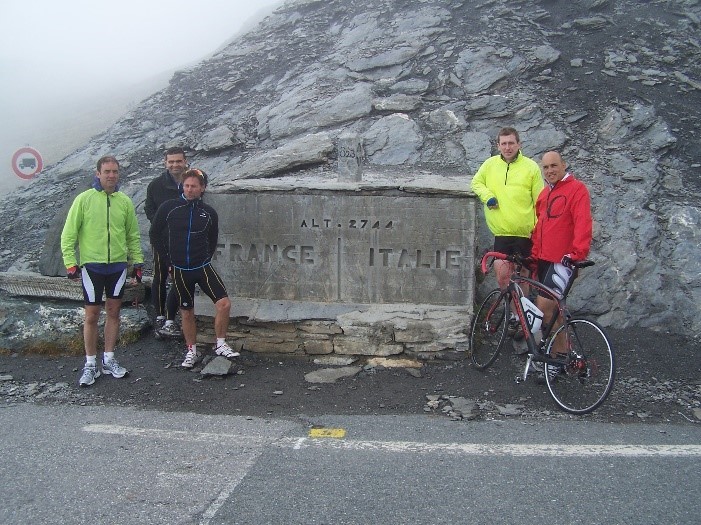Making friends with Gravity
There’s no doubt that the Dragon Ride, irrespective of distance, is a significant skyward challenge with ~4900m of ascent in the Dragon Devil, 3200m in the Gran Fondo and a ‘mere’ 2350m in the Medio Fondo. Equally undisputable is the impact of gravity! It may well be the least understood of the four fundamental forces known to science, but us cyclists know an awful lot about it. In essence, it stops us going uphill at the speeds that we achieve in our dreams and can scare us half-witted on the downslopes! Simple
So, what can you do to minimise its effect on you while riding those Welsh hills? Fortunately, I’ve forgotten everything that I learned about gravity during a Physics degree 30 years ago, so there’s no complicated theory to understand! Here are three strategies to consider:
Strategy 1: Buy lightweight things.
Sure, buying the latest, lightest, carbon fibre bike you can afford is going to save some weight but, unless you are a professional racer, it’s not really going to be the difference between ‘walking’ or ‘conquering’ that climb.
Of course, trying to complete a Dragon course on a 12Kg ‘Butcher’s Bike’ with 3-speed Sturmey Archer gears isn’t likely to succeed either and, as usual in life, I believe there’s a harmonious balance point to be found. That said, it never ceases to amaze me how often a group of riders will charge off at break neck speed from a sportive start line, only to come to a near standstill at the first significant climb. If you look closely at the riders that are pushing their bikes rather than pushing their gears, you’ll often see some very high end bikes piloted by a hand on the saddle.
Personally, I’d rather not be a member of the ‘All The Gear But No Idea’ club, so let’s look at the other more sensible strategies that are available.
Strategy 2: Chant your FTP.

Knowing a rider’s Functional Threshold Power (FTP), measured in Watts, is something that coaches such as I value very highly. In simplest terms, it is the highest power output that a rider can sustain for one hour. When you are riding above your FTP wattage you are ‘going into the red’ – i.e. your muscles are not getting enough oxygen and glucose and you cannot remove the waste carbon dioxide quickly enough. In other words, going in to the red – and staying there – means it won’t be long before you have to stop to recover.
Structured training that helps you raise your FTP is undoubtedly of benefit to any rider, as you will be able to do more work below it. However, having a higher FTP than your Dragon riding mate does not necessarily mean you’re going to get to the top before they do. Instead, it is your Watts per Kg (of bodyweight) that is a better indicator of an ability to go uphill, which means that a training programme should enable you to increase your FTP but also encourage you to lose weight.
The training that will increase your FTP wattage is just below that level, which is pretty intense but not excruciatingly painful. You’ll often see ‘Sweet Spot’ sessions or other intervals based on a rider’s FTP in their training plan, especially during winter months as they are very suitable for turbo trainer activities. If you don’t then you should ask questions as to why!
But what if you don’t know your FTP? The answer is, it really doesn’t matter! Training doesn’t have to be about tech or gadgets and great results can be achieved without either of them. As long as you are able to provide feedback on how you feel during your training sessions, then you are equipped to work with a coach! If you get told otherwise, then I’d suggest you ask them to buy a power meter for you, then watch as they change their position on the need for tech!
Strategy 3: Become a beanpole.
Imagine the leanest, meanest, fittest version of you careering towards the Black Mountain climb, all 5.3Km @5.8% with a 12% maximum gradient and 310m of vertical ascent. Over 9400 riders have tackled the eponymous Strava segment and a 300W average power is probably just about going to get you a place in the Top 200.
Back in the real world, let’s say that a more realistic average power for a reasonably fit rider is going to be 220W. Based on some very rough gazing through the Strava leaderboard and ignoring a rider’s weight, that’s probably going to be enough for a climbing time in the top 33%, or somewhere from 22-25 minutes. All in all, though, it would be something to be proud of.
Now, back to that weight thing – if you carried a couple of bags of sugar (just for fun) for extra weight, or lost a couple of kilos through diet, what impact might that have on your time?

Well, it is a piece of string question as it depends on a lot of factors, including rider weight, rotational wheel weight, aerodynamic drag and consistency (or not) of the road gradients. Anecdotally, though, a weight decrease of ~1Kg is going to save you ~1 min on a climb such as the Alpe d’Huez, if you can sustain ~270W for the duration. Now, you’re really not going to carry a couple of bags of sugar up the
Alpe d’Huez but you would be carrying water and, handily enough, 1litre of H2O weighs a convenient Kg. Two 750cl bottles could easily cost you 1.5 minutes on a climb as tough as the Alpe d’Huez, even if you can sustain 270W, so now you know why the professionals discard their bottles when the gradients go up!
Bearing in mind that the Alpe d’Huez is 13.2Km @ 8.1% – i.e. 2.5X the length of the Black Mountain and 50% steeper on average, that 1Kg saving is going to save you a mere few seconds, maybe 10-15 at most. You’ve therefore got to lose quite a few kilos – as well as keep your muscle mass to be able to maintain the same power – if weight-loss is your go-quickly-uphill strategy.
Summary: One size does not fit all
In order to finish the Dragon Rides there’s no doubt that correct preparation is absolutely paramount for success. As we have seen, weight loss (or gain) will have an impact on your rate of climbing, assuming that all of the other factors are conveniently ignored. Equally, I hope I have shown the gains from weight reduction alone are small for most sportive riders but firmly in the camp of ‘significant marginal gains’ for the professional elites.
In my opinion, the best approach that Dragon Ride entrants can take is to recognise that fitness, equipment, nutrition and the physical body are intrinsically linked to success and that all of them have to be managed during the build up. The health of every human being is a combination of these factors and they need to be in balance with each other, if you want to perform at your best during your Dragon exploits

In many ways, this is not dissimilar to the requirements of a motor car. We take it for granted that a car needs nutrition (fuel); training (engine tuning) and to be in good physical (MOTs, Services) condition. If we neglect any of these factors for our cars, they would soon let us know by stopping working! So, I always encourage riders to try to regard themselves as being a ‘whole’ that is much better than the individual parts. In other words, the best way to train is to recognise that we are a ‘system’, not a set of parts!
There is one further element that is vital during ride preparation and that is mental strength.
Unfortunately, my car analogy breaks down (excuse the pun!) at this point, at least until we all have driverless cars! More thoughts on mental preparations in future posts but I’ll leave the following thought with you. When you think your body has completely “had it”, there’s a least 100 miles in the reserve tank – you just need to know how to tap in to those reserves.
Andy Tomkins
Director – Sportive Cycle Coaching
